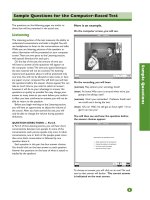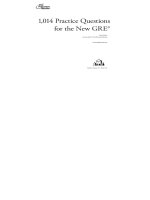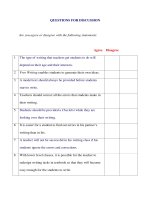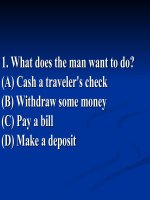Questions for chapter 1
Bạn đang xem bản rút gọn của tài liệu. Xem và tải ngay bản đầy đủ của tài liệu tại đây (0 B, 7 trang )
1. What are 5 steps in negotiating delivery?
An overview of the five negotiating steps is suggested to simplify discussion of the
ideas and to avoid problems: Timing, Location, Transport, Risk Title and
Insurance, Terms of Trade.
2. When must delivery take place?
Good negotiators should mention a delivery date in negotiating the timing of an
export deal and then other issues relating to coming into force, delay and
compensation for delay, use a straight forward calendar date to name the delivery
date. The date of coming into force is not usually a calendar date, but the date on
which the last precondition is met. Common preconditions are:
+ Receipt of import and/ or export approval
+ Receipt of foreign exchange approval from a central bank
+ Issuance of a letter of credit or bank guarantee.
+ Making of a down-payment by the buyer
+ Issuance of an insurance policy
+ Issuance of a certificate of origin
+ Delivery by the buyer of plans, drawings or other documentation.
- Negotiators may agree on a cut-off date: if the contract has not come into force
within a certain time, then it becomes null and void.
3. What is the place of delivery?
Place of delivery: is the point at which the exporter passes responsibility for the
Goods to the Buyer. Delivery can take place at a number of places between
manufacturer’s factory and the Buyer’s warehouse.
4. Why is location important?
Because it is the point at which the exporter passes responsibility for the Goods to
the Buyer. A convenient location can lower transportation costs and minimize time
in transit, reduce the risk of delays of goods from suppliers as a result of delays
experienced along the transit route.
5. Why is transportation important?
The transportation sector is responsible for all of international trade in goods.
Trade costs paid by exporters, as well as the ensuing trade flows are largely shaped
by the behavior of transportation companies.
6. What are modes of transportation?
Sea transport, air transport and Inland transport (by road, by rail, by barge, by
mail or by mixture).
7. Where is the risk often passed from the exporter to the importer?
At the point of delivery.
8. Where does transfer of ownership take place?
When the shipping documents are delivered to the buyer and he receives them by
paying price of the goods
9. How many kinds of delay in delivery?
Excusable delay, Non - excusable delay
10.What is excused delay?
It is caused by an Force Majeure event.
11.What events does delivery date trigger?
Exporter fulfills duties under the contract
Payment may become due
Risk and title pass to the buyer
12.How to fix delivery date?
To use a straightforward calendar date or interval times
13. When does the contract come into force?
When all the preconditions have been met.
14. When is a contract binding? After the signature date.
15.When is a contract binding and effective?
After the date of coming into force.
16.In what kind of contract is a cut-off date set?
If the contract has not come into force within a certain time.
17.How does the date of coming into force affect the delivery date?
The delivery date is normally fixed for a certain days after the date of
coming into force.
18.What is the grace period?
It is the period between the delivery date and the day of the beginning
penalty period.
19.What is the grace period used for?
It uses for facilitating early delivery.
20.What can parties do if the force majeure events continue too long?
The duties under the contract can be suspended or terminated altogether.
21.What are the 3 outcomes of FM?
Resumption of delivery
Termination of contract
Unclear and dangerous situation
22.What are the two remedies given to the Buyer for any unexcused delay?
Requiring the exporter to make delivery as agreed
Fully and adequately compensation.
23.Which law prefers to award damages? It is subject to some national law.
24.Which law enforces performance? Common Law
25.What questions do the courts ask in setting a figure for compensatory
damages for late delivery?
Did the loss provably follow from the breach?
Was the loss reasonably close to the breach in the chain of events?
Did the buyer take reasonable steps to keep the loss as small as
possible.
26.What are liquidated damages?
A fair figure, a lump sum to be paid per day (week or month) of late
delivery, agree by both parties.
27.What are penalties?
Damages are paid to compensate one party for a loss
28.Explain the differences between liquidated damages and penalties
The difference is that the motive behind them. Liquidated damage is a fair
pre estimate and a penalty is an attempt to terrorize.
29.What is quasi-indemnity?
It is a compensation figure so low that it relieves a seller's responsibility for
late delivery.
30.What notation must a Marine Bill of Lading bear? Loaded on board.
31.How can a marine bill of lading be made into a negotiable document?
Typing the word "Order" in the consignee box.
32.What are clean shipping documents?
Shipping documents are free of notes about defects.
33.What aspects of the goods does the carrier (the transportation company)
inspect? – The packaging only.
34.What defects does the carrier note on the face of the bill of lading or other
shipping documents?
Packaging, weight or general appearance of the goods.
35.Which player (exporter or buyer) is responsible for arranging insurance
cover?
There are two schools of thought.
The first sees the point of delivery as decisive, up to deliver the
exporter insures, after the delivery the buyer.
The second approach lies behind C term, the exporter arrange
insurance.
36.Name types of insurance policy: Floating Policy and Open cover.
37.What does a Marine Insurance policy cover?
It contains clause A, B and C. Clause A covers anything not excluded;
clause B and C exclude anything not expressly covered.
38. What are 3 variables taken into account when setting up the 13 terms?
Point of delivery, transport and Costs after delivery.
39. Identify 4 categories in which the 13 terms are grouped
Each type is divided into four groups: E, F, C and D. These categories are
determined by the delivery location and who is responsible for covering the
cost of each part of the journey. The groups are then split into sub-categories
which refer to various scenarios.
40.What are main functions of ocean BL?
It uses for payment by an LC.
41.What are requirements of BL when payment is made by LC? – Clean BL









